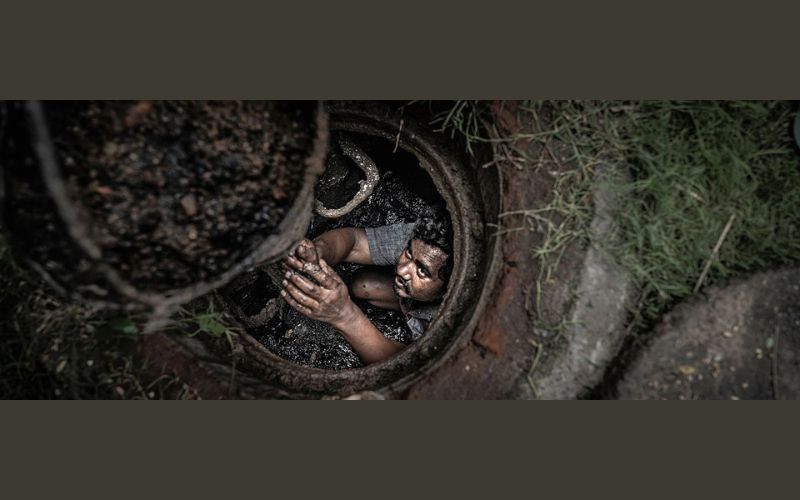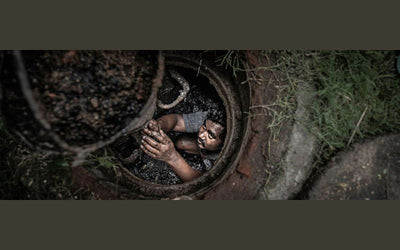How Do I Know If My Drainage System is Failing Before It’s Too Late? | Drainage Cleaner Tips

You’ll know your drainage is starting to fail when little things feel “off” — water taking forever to drain, odd noises in the pipes, or a faint smell you can’t ignore.
With only around 42% of urban households currently connected to sewerage or septage systems in AMRUT cities, many homes still rely on onsite systems that can silently decline if neglected. Spotting early warning signals, slow drains, odd gurgles, stray wet patches — gives you a chance to fix things cheaply, instead of paying for major repairs later. Using a reliable drainage cleaner and routine septic tank cleaning are some of the simplest ways to prevent these drainage failures from starting in the first place.
Signs You Can See, Hear, and Smell (Before It’s Too Late)
You don't need to wait for a complete backup to realize your drains are in distress. Slow-moving water, unusual sounds, or lingering smells are red flags your system requires attention.
Slow-Moving Drains
If your sink, shower, or bathtub is taking noticeably longer to empty than it did a year ago—or compared to other drains in your home—that's more than just a minor inconvenience. It's an early warning sign that shouldn't be ignored.
Slow drains are often the first noticeable symptom of a progressive buildup of materials like grease, hair, soap scum, and food particles. Over time, these accumulations can escalate into more serious issues, such as sewer backups or increased pressure on septic systems. Local municipal reports indicate that chronic clogging remains a persistent problem in many cities, despite efforts to address it. Ignoring septic tank cleaning schedules often worsens the problem, as sludge build-up restricts flow and increases system pressure.
Strange Sounds
If you hear gurgling, bubbling, or air-popping noises when using another fixture, it’s more than just a quirky sound—it indicates trapped air or partial blockages. This often points to a more serious pipe or venting issue than a simple surface clog.
These noises usually result from air pockets traveling within your plumbing, often caused by partial clogs or improper venting. The PLOS report also identifies that malfunctioning onsite systems can also cause offsite discharge of effluent, underscoring the essence of having proper system function.
Unpleasant Odors
When you perceive that sewer smell around your system of fixtures, drains, or even outdoors at or near inspection chambers, and even after cleaning, it is a warning. That is not regular domestic soil; it means there is something underneath that either oil or grease is gone.
Noxious smells usually indicate issues with things like broken seals, clogged traps, or effluent that is looking to rise on the surface or venting through breaks in lines. Peer reviewed research and local reporting show that failing containment, such as septic tanks discharging to drains or choked drains, leads to odor and public health risks. The PLOS study highlights how malfunctioning onsite wastewater systems can result in effluent discharge, posing health hazards.
Consistent septic tank cleaning can prevent this effluent overflow and keep household drains odor-free.
Recurring Backups
If you find yourself constantly extending your arm for the plunger in the same location, it's not a persistent clog—it's probably a more serious problem. Repeated backups tend to indicate a deteriorating line, tree-root infiltration, or overloaded septic soakaway. In such cases, using a drainage cleaner can help maintain flow temporarily, but it’s essential to address the underlying issue before it leads to complete system failure.
Local reports show that backup at the level of the household tends to be symptomatic of network or capacity issues. For example, the Dhanwapur sewage system in Gurgaon is almost working at its full capacity of 218 MLD, resulting in regular backups and spillovers.
Why These Failures Happen in the First Place
You may consider a clogged drain or a strange spot of water in your backyard as "bad luck." Actually, though, drainage failures seldom occur overnight. They are normally the product of a few small, mundane events building up over time.
- Regular habits: Flushing wet wipes, pouring grease down the sink, or letting hair and soap scum pile up doesn’t seem like much day-to-day. But over months and years, these habits can build blockages that silently strain your pipes.
- Aging soakaways and pipes: Just like any component of your property, pipes and soakaways depreciate. Soakaways that get blocked, crack, or corrode lose efficiency, and before you realize it, water no longer flows as before. Even homes with a plastic septic tank can experience similar failures if routine cleaning and inspection are skipped.
- Maintenance gaps: Even if you’re careful, if the system isn’t checked and cleaned regularly, small issues snowball. Scheduled desludging isn’t just a suggestion — studies from cities like Wai show it prevents backups and keeps your drainage system healthy.
- Municipal capacity limits: On top of that, many urban sewer networks and treatment plants are already stretched. AMRUT and CPCB data show that gaps in coverage and overloaded STPs mean that household drains often bear the brunt of bigger systemic issues.
What You Can Do Right Now (Practical Self-Checks)
A few simple checks today can tell you if your system is quietly struggling — and catching problems early saves time, money, and stress. Here’s how you can do it:
- Do the 60-Second Sink Test: Fill a sink and drain it. If water pools after 60 seconds or drains slower than other sinks, flag it immediately.
- Perform a Smell Test: After a day without water use, sniff traps, manholes, and inspection chambers. Persistent sewer odors mean action is needed.
- Walk Your Yard After Dry Days: Look for wet lines, lush patches, or depressions.
- Listen for Plumbing Sounds: Run a bath or flush the toilet. Gurgles or bubbles in unrelated fixtures signal trapped air or partial blockages — get a plumber to check.
- Track Recurring Issues: Log date, fixture, and action. If the same problem repeats more than twice a month, escalate to professional inspection.
Do the 60-second sink test now. Spot a problem? Treat it early with Bioclean, an enzyme-based drainage cleaner and septic tank cleaner that keeps your drains healthy and helps you avoid expensive repairs.
Bioclean uses naturally occurring enzymes to break down solid waste, grease, and sludge in your septic system. Unlike chemical cleaners that just mask symptoms or risk damaging pipes, Bioclean supports the natural bacterial balance in your tank, helping prevent blockages and backups before they start. Regular use keeps your system running smoothly, so minor issues don’t become major expenses. Whether you have a traditional or plastic septic tank, Bioclean ensures long-term hygiene and performance.




